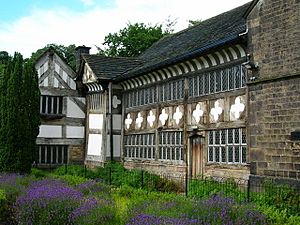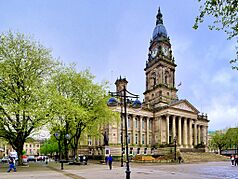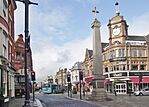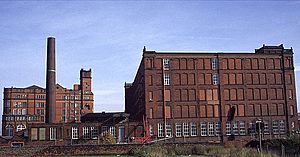Bolton facts for kids
Quick facts for kids Bolton |
|
|---|---|
| Town | |
|
|
| Population | 296,000 (2021 Census) |
| OS grid reference | SD715095 |
| Metropolitan borough |
|
| Metropolitan county | |
| Region | |
| Country | England |
| Sovereign state | United Kingdom |
| Post town | BOLTON |
| Postcode district | BL1-BL7 |
| Dialling code | 01204 |
| Police | Greater Manchester |
| Fire | Greater Manchester |
| Ambulance | North West |
| EU Parliament | North West England |
| UK Parliament |
|
Bolton is a lively town in Greater Manchester, England. It's nestled near the West Pennine Moors, surrounded by other towns like Manchester, Blackburn, and Wigan. Bolton is the main town in the wider borough, which includes many smaller towns and villages. It's also part of the historic county of Lancashire.
For a long time, Bolton was famous for making textiles. Since the 14th century, when weavers from Flanders settled here, it has been a centre for wool and cotton weaving. During the 1800s, Bolton became a "boomtown" thanks to the Industrial Revolution and new textile machines. At its busiest in 1929, Bolton had 216 cotton mills and 26 places for bleaching and dyeing fabrics. This made it one of the biggest cotton spinning centres in the world! However, after the First World War, the cotton industry slowly faded away, and by the 1980s, most cotton production had stopped.
Today, Bolton is home to about 139,403 people, while the whole borough has around 262,400 residents. The town started as a small settlement called Bolton le Moors. During the English Civil War in 1644, Bolton was a stronghold for the Parliamentarian side in an area mostly loyal to the King. This led to a major event where Royalist troops attacked the town.
The Bolton Wanderers football club plays its home games at the Toughsheet Community Stadium in Horwich. Bolton also has cool cultural spots like the Octagon Theatre and the Bolton Museum and Art Gallery. It was also one of the first towns to open a public library after a special law was passed in 1850.
Contents
History of Bolton
What's in a Name?
The name Bolton comes from old English words meaning "a settlement with a dwelling." It was first recorded as Boelton in 1185. Over time, its name changed a few times before becoming Bolton after 1307.
The town's motto, Supera Moras, means "overcome difficulties." It's a clever play on words, as an older version of the town's name, "Bolton-super-Moras," literally meant "Bolton on the moors."
Early Times to the Civil War
People have lived around Bolton since the Bronze Age, thousands of years ago. You can still find signs of them, like a stone circle on Cheetham Close and burial mounds on Winter Hill. The Romans also built roads nearby.
In the 1300s, weavers from Flanders came to Bolton and started making woollen cloth. Later, more Flemish weavers, who were escaping difficult times, settled here in the 1600s. They introduced a new type of fabric called fustian, which was a mix of linen and cotton. People also started digging for coal in the area as early as 1374.
During the English Civil War, Bolton was a strong supporter of the Parliamentarian side. In 1644, the Royalist army, led by Prince Rupert of the Rhine, attacked the town. This event, sometimes called "The Bolton Massacre," was a very difficult time for the town. Many people were affected, and the town was plundered. After the war, one of the Royalist leaders, the Earl of Derby, was executed outside the historic Ye Olde Man & Scythe pub in Bolton.
The Industrial Revolution and Beyond
Bolton grew incredibly fast during the 1800s because of the Industrial Revolution. It became a world leader in cotton spinning. Local inventors like Richard Arkwright and Samuel Crompton made huge improvements to spinning machines. Crompton, who lived at Hall i' th' Wood, invented the spinning mule in 1779. This machine made it much easier to produce high-quality yarn.
The many streams flowing into the River Croal provided the water needed for bleach works, which cleaned and whitened the cotton. The invention of steam power meant huge multi-storey mills could be built, changing Bolton's skyline forever.
The availability of coal in the area also helped the textile industry grow. Coal mines provided fuel for the steam engines that powered the mills. Important transport links, like the Manchester Bolton & Bury Canal (built in 1791) and the Bolton and Leigh Railway (opened in 1828), helped move coal, raw cotton, and finished goods.
By 1911, about 36,000 people in Bolton worked in the textile industry. However, after the 1920s, the cotton industry began to decline, and by the end of the 20th century, it had almost disappeared.
During the First World War, in 1916, Bolton was attacked by a German Zeppelin airship. Bombs were dropped on the town, causing damage and sadly, some deaths.
Lord Leverhulme's Gifts
Lord Leverhulme, a famous industrialist, bought Hall i' th' Wood in 1899. He restored it and gave it to the town in 1902 as a museum. He also supported Bolton School and gave land for a public park, which was named Leverhulme Park in 1914. In 1902, he gave the people of Bolton another park at Rivington. Lord Leverhulme had big plans to rebuild Bolton's town centre, but the council decided to focus on extending the town hall instead.
How Bolton is Governed
Bolton is part of Greater Manchester. It is governed by the Bolton Council, which has councillors elected from different areas of the town.
For a long time, Bolton was made up of two main areas, Great Bolton and Little Bolton, separated by the River Croal. In 1838, Bolton became a municipal borough, which meant it could govern itself more. Later, in 1889, it became a County Borough, making it even more independent. In 1974, the County Borough of Bolton became part of the larger Metropolitan Borough of Bolton in Greater Manchester.
Bolton is twinned with two cities: Le Mans in France (since 1967) and Paderborn in Germany (since 1975). This means they have special friendly connections and cultural exchanges.
Bolton's Geography
Bolton is located about 10 miles (16 km) northwest of Manchester. It sits among low hills on the edge of the West Pennine Moors. The River Croal flows through the town.
The land around Bolton is mostly made of sandstone and Coal Measures, which explains why coal mining was important here in the past. If you look north from Bolton, you'll see Rivington Pike and the Winter Hill TV Mast on the West Pennine Moors.
 |
Horwich | Egerton and Chapeltown | Tottington |  |
| Aspull and Blackrod | Little Lever and Radcliffe | |||
| Westhoughton | Atherton and Tyldesley | Farnworth and Kearsley |
Bolton's climate is similar to the rest of England, with mild temperatures and rain throughout the year.
People of Bolton
In 2021, Bolton had a population of about 296,000 people. The town is quite diverse, with people from many different backgrounds living here. Most people in Bolton were born in England, but many also come from other parts of the UK and the world.
In terms of religion, most people in Bolton identify as Christian. There are also significant Muslim and Hindu communities, as well as people with no religious beliefs.
Bolton's Economy
Today, Bolton's economy is very different from its past. Instead of heavy industry like cotton mills, the town now focuses on service-based jobs. This includes things like data processing, call centres, and technology companies.
However, Bolton still has some traditional industries, such as paper manufacturing, packaging, and textiles. The European headquarters for the sports brand Reebok are located here. Bolton is also home to the famous family bakery, Warburtons, which started in 1876.
Bolton is a popular place for shopping, with many shops, markets, restaurants, and cafes in the town centre. There are also retail parks and leisure facilities nearby. Tourists visit attractions like Hall i' th' Wood, Smithills Hall, and the Bolton Steam Museum.
The town has big plans for the future, with several projects aimed at improving the town centre. These projects will create new business spaces, homes, and leisure areas. The University of Bolton is also at the heart of a large development called the Bolton Innovation Zone.
Famous Landmarks

In the heart of Bolton, you'll find the impressive Bolton Town Hall. This beautiful building was designed by William Hill and opened in 1873. Inside, there are the Albert Halls, which host events and performances. The original Albert Hall was damaged by fire in 1981 but was rebuilt and reopened in 1985.
Smithills Hall is a very old building, with parts dating back to the 14th century. It's now a museum where you can learn about its history. A famous story says that in 1555, a man named George Marsh stamped his foot so hard during a trial for his beliefs that he left a footprint in the stone floor!
Hall i' th' Wood is another historic house, now a museum. It was built a long time ago by a farmer. Samuel Crompton, the inventor of the spinning mule, lived and worked here. In the late 1800s, William Hesketh Lever (Lord Leverhulme) bought and restored it, then gave it to the town.
Bolton has many historic buildings and beautiful parks. Some notable places include Le Mans Crescent, the old Ye Olde Man & Scythe pub, and the Bolton Market Hall (built in 1854). Outside the town centre, you can see Smithills Hall and the impressive All Souls Church. Looking north, the views are often dominated by Rivington Pike and the Winter Hill TV Mast.
Getting Around Bolton
Bolton has good road connections. The A6 passes to the west, and the A666 dual carriageway goes through the town centre, connecting to the M61 motorway.
Local buses, part of the Bee Network, serve Bolton and the surrounding areas. Bolton also has a main train station, Bolton Interchange, which offers services to Manchester, Wigan, Blackburn, Preston, and other cities.
Education in Bolton
Bolton has many schools for different age groups. Bolton School, a private school, started as a grammar school for boys in 1524. It later merged with a girls' school and moved to its current location. Other secondary schools in the town include Canon Slade School, Ladybridge High School, and Thornleigh Salesian College.
For older students, Bolton College offers further education courses. The University of Bolton gained university status in 2005 and is a key part of the town's development.
Religion in Bolton
Christian churches have been in Bolton since Saxon times. Over the years, many different Christian groups, like Methodists and Baptists, established churches. More than forty churches were built during the Victorian era, though some have since been closed or changed.
The Church of St Peter, also known as Bolton Parish Church, is a beautiful example of Gothic Revival architecture. It was built between 1866 and 1871. There have been churches on this site since Anglo-Saxon times.
St Mary's Deane is another very old church, dating back to 1250. There are also other churches like St George's Church and St Patrick's Roman Catholic Church. Bolton also has mosques and Hindu temples, reflecting the town's diverse community.
Sports in Bolton
Bolton Wanderers F.C. is a famous English Football League club. They were formed in 1874 and played at their old ground, Burnden Park, for over 100 years. In 1997, they moved to their current home, the Toughsheet Community Stadium in Horwich. The club has won the FA Cup four times.
Bolton also has a hockey club, a local cricket league, and a rugby union club called Bolton RUFC, which started in 1872. For something a bit different, there's the Bolton Robots of Doom baseball club and the Bolton Bulldogs American football team.
Culture and Society
People often say that Boltonians are some of the friendliest people in Britain!
Bolton has several theatres, including the Octagon Theatre. Famous comedian Peter Kay was once part of the Octagon's youth theatre, and director Danny Boyle was inspired to start his career there. The Albert Halls inside the Town Hall also host performances.
The Bolton Museum and Art Gallery has a great collection of local and international art. The Bolton Steam Museum showcases old steam engines. You might even see Bolton in films or TV shows, as places like Le Mans Crescent have been used as filming locations.
Bolton Central Library was one of the first public libraries in the country, opening in 1853. The Bolton Symphony Orchestra performs regularly in the town. Bolton also has its own daily newspaper, The Bolton News, and a local radio station, Bolton FM.
The town also hosts Bolton LGBT+ Pride every year, which includes a parade and live music, celebrating diversity and inclusion.
Public Services
The Greater Manchester Police keep Bolton safe. The Greater Manchester Fire and Rescue Service provides fire and rescue services from several stations in the area. For healthcare, the Royal Bolton Hospital provides emergency and other hospital services. Local doctors, nurses, dentists, and pharmacists are also available.
Famous People from Bolton
Many notable people have come from Bolton!
- Samuel Crompton (1753–1827) – The inventor of the spinning mule, which changed the textile industry.
- Lord Leverhulme (1851–1925) – A famous industrialist and generous supporter of Bolton.
- Fred Dibnah – A steeplejack who became a popular TV historian.
- Amir Khan – A world champion boxer.
- Peter Kay – A well-known comedian.
- Philip Craven – The former president of the International Paralympic Committee.
- Bill Naughton – A playwright and author who grew up in Bolton.
Images for kids
Error: no page names specified (help). In Spanish: Bolton para niños
In Spanish: Bolton para niños




















